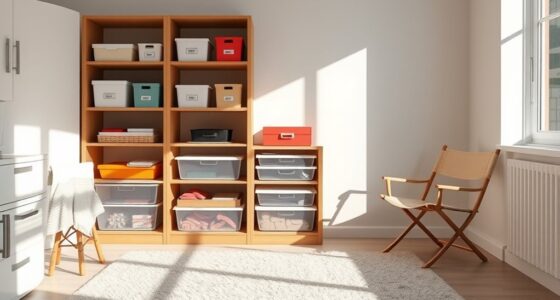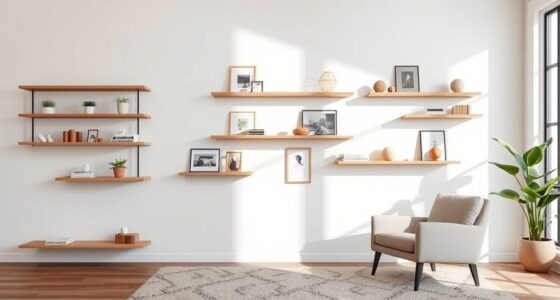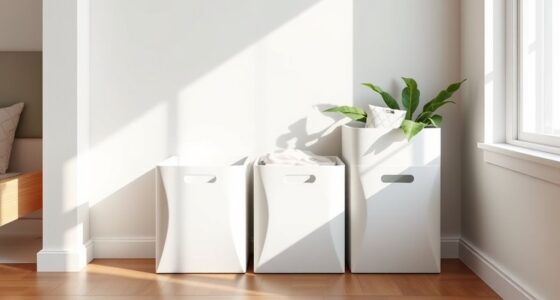I've found some incredible decluttering tools that can really streamline your life and boost productivity. From "Decluttering at the Speed of Life," which offers relatable advice, to "The Joy of Less," focusing on minimalism, these resources provide practical tips. "Effortless ADHD Organization" is great for those needing bite-sized strategies, while "The Declutter Challenge" encourages community support. Each book has unique insights that can transform your space and mindset. Stick around, and I'll share more about these tools!
Key Takeaways
- Utilize the 6-Box System for sorting items into categories like keep, donate, and discard, simplifying decision-making during decluttering.
- Implement checklists to track progress and ensure all areas are addressed systematically, enhancing accountability and focus.
- Adopt zone cleaning strategies to tackle specific areas, preventing overwhelm and making the decluttering process more manageable.
- Repurpose everyday items like boxes and baskets for storage solutions, providing budget-friendly organization tools that suit any room.
- Establish a regular decluttering schedule to maintain order and prevent clutter accumulation, fostering long-term productivity and a streamlined environment.
Decluttering at the Speed of Life

If you're someone who feels overwhelmed by clutter and struggles to keep your space organized, "Decluttering at the Speed of Life" might just be the perfect resource for you. Dana K. White's engaging and humorous writing style makes her advice relatable and easy to digest. I found her practical strategies invigorating, especially since she emphasizes making gradual progress without feeling guilt. The book's structure, focusing on a decluttering mindset and actionable steps, helped me tackle my clutter room by room. It's a real game changer, inspiring me to celebrate small victories rather than aiming for perfection. You'll feel motivated to start!
Best For: This book is best for individuals who feel overwhelmed by clutter and are seeking practical, relatable strategies to declutter their spaces gradually.
Pros:
- Engaging and humorous writing style that makes the advice relatable and enjoyable.
- Emphasizes gradual progress, allowing readers to declutter without feeling overwhelmed or guilty.
- Clear structure with actionable steps that help tackle clutter room by room.
Cons:
- Some readers may desire a deeper exploration of emotional attachments to clutter.
- The straightforward approach may not address complex organizational issues for everyone.
- Readers familiar with other decluttering methods might find some concepts repetitive.
The Sentimental Persons Guide to Decluttering
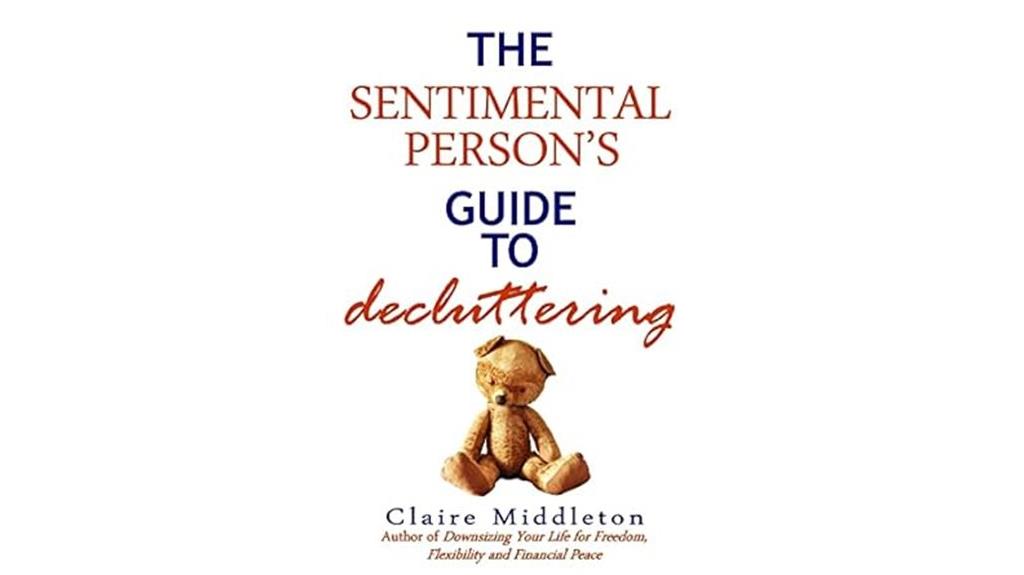
For anyone who finds it hard to part with cherished possessions, "The Sentimental Persons Guide to Decluttering" is an invaluable resource. It provides practical strategies that truly resonate with those of us who feel attached to our belongings. I've found the grouping method—like tackling books and clothing together—extremely helpful. It simplifies decisions and eases guilt about letting go. This book also addresses the emotional weight we carry, reminding us that gifts shouldn't feel like obligations. Overall, I appreciate its approachable style and motivational tone, making the intimidating task of decluttering feel manageable and even liberating.
Best For: Individuals who struggle with emotional attachment to their possessions and are seeking practical strategies for decluttering.
Pros:
- Offers relatable advice tailored to sentimental individuals, making the decluttering process feel less daunting.
- Introduces effective strategies like grouping similar items, simplifying decision-making and reducing overwhelm.
- Addresses emotional challenges, helping readers shift their perspectives on gifts and obligations.
Cons:
- Some readers may find the information to be basic if they are already familiar with decluttering principles.
- The book may not provide advanced techniques for those seeking a more rigorous approach to minimalism.
- Emotional challenges may still linger for some readers, despite the book's supportive tone and strategies.
Effortless ADHD Organization: Life Hacks for Adults with ADHD
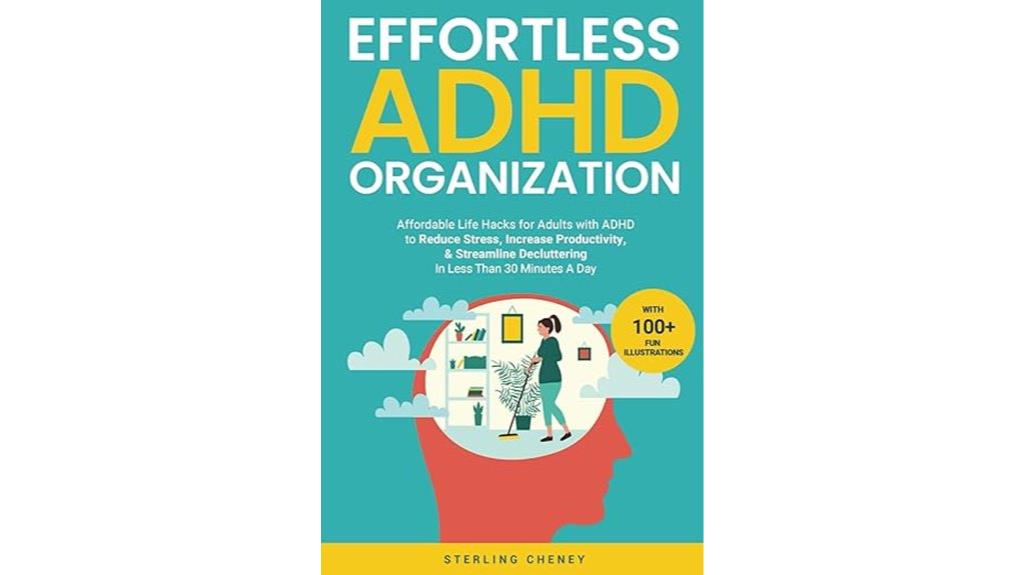
Effortless ADHD Organization is tailored specifically for adults grappling with the challenges of ADHD, offering practical solutions to the chaos that often accompanies daily life. I've found its bite-sized chapters and humorous cartoons make organization feel less intimidating and more enjoyable. Strategies like zone cleaning and bullet journaling really resonate with me. The 30-minute daily routines break things down into manageable tasks, while color-coding helps me prioritize effectively. Plus, the supportive tone reassures me that progress is possible without perfection. If you're looking to reduce stress and boost productivity, this book is an invaluable resource for conquering clutter.
Best For: Adults with ADHD seeking practical and engaging strategies to manage chaos and improve organization in their daily lives.
Pros:
- Features bite-sized chapters and humorous cartoons that make the content relatable and engaging.
- Offers actionable strategies like zone cleaning and bullet journaling, making organization feel manageable.
- Provides a supportive tone that encourages progress without the pressure of perfection.
Cons:
- Some readers may find the lighthearted approach less effective if they prefer more serious, structured guidance.
- The strategies may require consistent effort and practice, which can be challenging for individuals with ADHD.
- Not all techniques may resonate with every reader, as individual preferences and needs vary.
The Joy of Less: A Minimalist Guide to Declutter, Organize, and Simplify

Embracing minimalism can be a transformative journey, especially for those overwhelmed by clutter and the chaos it brings. "The Joy of Less" by Francine Jay offers practical guidance tailored for individuals seeking a simpler, more organized life. Jay encourages us to rethink our relationship with possessions, emphasizing what truly serves us. Her actionable strategies, like the "one in, one out" rule, help maintain a clutter-free environment. By regularly evaluating and decluttering our spaces, we create room for mental clarity and relaxation. Ultimately, this minimalist lifestyle fosters deeper connections and allows us to focus on what genuinely matters.
Best For: Individuals seeking to simplify their lives and reduce clutter in a personalized and practical manner.
Pros:
- Encourages a positive mindset towards possessions, fostering a healthier relationship with belongings.
- Provides actionable strategies that can be easily implemented in daily life to maintain a clutter-free environment.
- Helps individuals experience mental clarity and focus on meaningful relationships and activities.
Cons:
- May require a significant time commitment for thorough decluttering and organizing.
- Some readers may feel overwhelmed by the emotional attachment to possessions, making it difficult to let go.
- The minimalist lifestyle may not resonate with everyone, particularly those who value collections or sentimental items.
The Declutter Challenge: A Guided Journal for Home Organization

If you're feeling overwhelmed by clutter but crave a structured approach to tackle it, "The Declutter Challenge: A Guided Journal for Home Organization" could be your perfect companion. This journal offers practical guidance with clear steps that help you reflect on your habits and understand your emotional ties to clutter. I found it motivating to read others' transformations, like removing bags of unwanted items and recognizing patterns in clutter tendencies. The supportive community aspect really kept me engaged, and the adaptable format fits various lifestyles. It's an invigorating resource that stands out among typical organizing books, making it a must-have for anyone ready to declutter.
Best For: Individuals seeking a structured and supportive approach to decluttering their homes and habits.
Pros:
- Clear, concise guidance with step-by-step instructions tailored to individual circumstances.
- Fosters a sense of community and motivation among readers, helping them stay committed to their decluttering journey.
- Adaptable format suitable for various lifestyles, including those with chronic illnesses or disabilities.
Cons:
- Some readers may find the content too basic for advanced decluttering needs.
- The journal format may not appeal to those who prefer traditional organizing books without writing prompts.
- Limited depth on specific decluttering methods might not satisfy all readers' expectations.
Top-To-Bottom Home Organizing Guide

Are you feeling overwhelmed by clutter and unsure where to start? "Top-To-Bottom Home Organizing" by Caralyn Kempner is an ideal choice for anyone looking to transform their living space into an organized haven. This thorough guide breaks down organization by room, offering practical advice and helpful checklists. I love the hand-drawn illustrations that clarify concepts and make the process less intimidating. Whether you're a homeowner or an aspiring professional organizer, this book provides budget-friendly solutions and strategies for every space. It's an inspiring resource that encourages small, manageable steps toward creating a clutter-free environment. You won't regret diving in!
Best For: Individuals looking to declutter their homes and aspiring professional organizers seeking effective strategies and budget-friendly solutions.
Pros:
- Comprehensive: Covers organization strategies for every room in the home with practical advice and checklists.
- Illustrative: Features clear hand-drawn illustrations that enhance understanding and make the process less intimidating.
- Inspiring: Encourages readers to take small, manageable steps towards creating an organized living space.
Cons:
- Limited Scope for Small Spaces: May not cater well to those living in smaller environments or those resistant to acquiring more organizational tools.
- Familiar Concepts: Some readers may find the ideas not groundbreaking compared to other organizing books.
- Product Dependency: The reliance on specific storage products may not appeal to all, especially those on a tight budget.
Doable Decluttering Workbook: Proven Methods to Organize Your Home
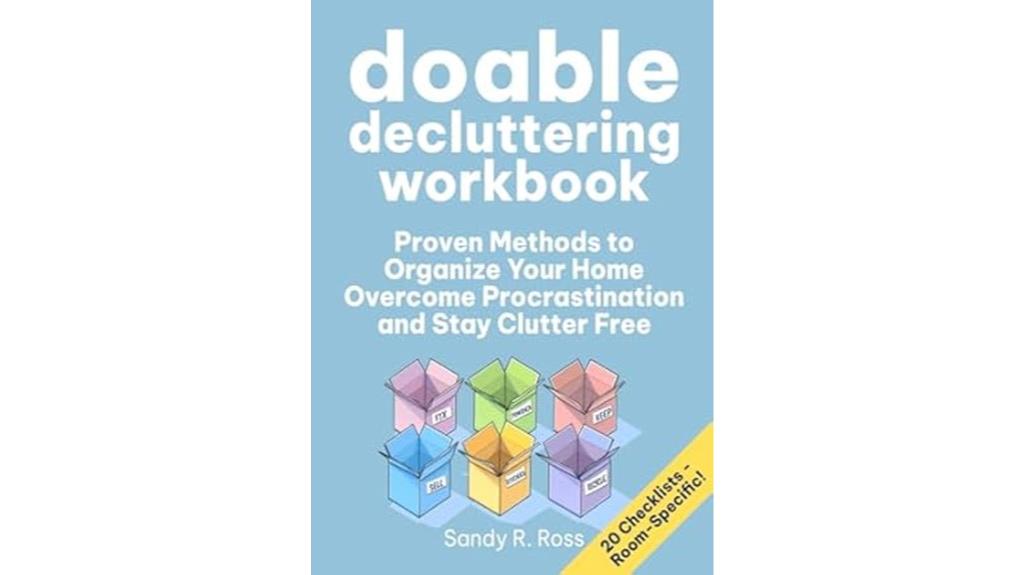
The "Doable Decluttering Workbook: Proven Methods to Organize Your Home" is perfect for anyone who feels overwhelmed by clutter and struggles to get started. This motivational guide breaks down the decluttering process into manageable steps, making it easy to track your progress with before and after comparisons. I appreciate how it addresses emotional connections to belongings, offering compassionate advice for letting go. The practical strategies, like the 6-Box System and room checklists, really help streamline the process. Plus, the workbook's flexibility allows me to move at my own pace—no pressure for perfection here! It's truly a game changer.
Best For: Individuals who feel overwhelmed by clutter and need a structured, compassionate approach to decluttering their home.
Pros:
- Provides a step-by-step process that makes decluttering manageable and tracks progress effectively.
- Offers emotional insights and compassionate advice, helping users honor their feelings while letting go of belongings.
- Includes practical strategies like the 6-Box System and room checklists, making the organization process more straightforward.
Cons:
- Some users may find certain tips or strategies less applicable to their unique situations.
- The workbook's flexible approach may lead to a lack of urgency for those who thrive on strict timelines.
- Requires commitment and consistent effort from the user, which may be challenging for some.
Declutter Your Home: Make more room for life
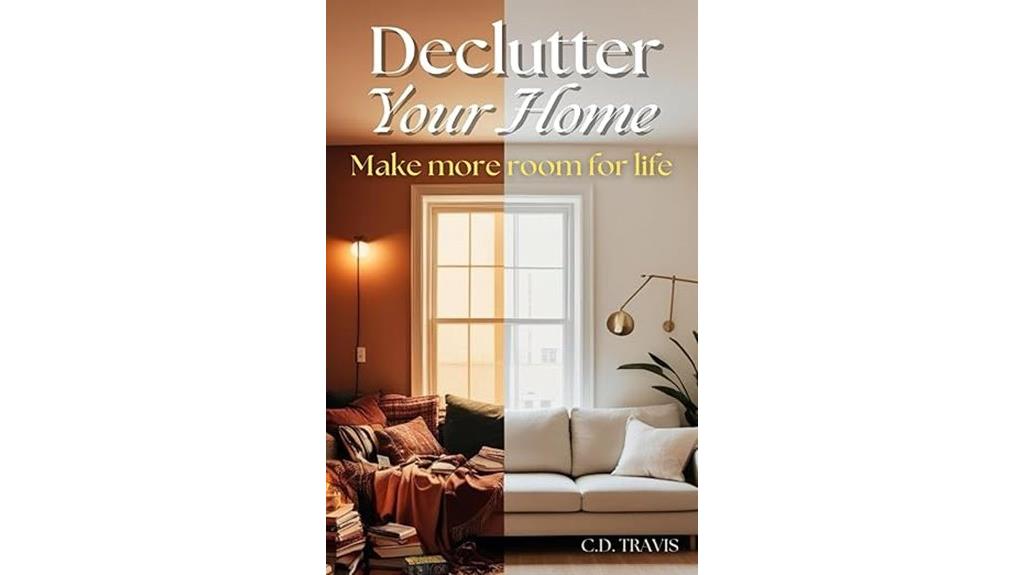
For anyone feeling overwhelmed by the chaos of their living space, "Decluttering Tools" is the perfect guide to reclaiming your home. I've found that using strategies like the "Rule of Three" and setting aside just 10 minutes a day makes decluttering manageable. It's amazing how much stress lifts when I create a peaceful environment. Involving my family turns it into a fun team effort, and we all enjoy the extra space. The practical tips for organizing and managing sentimental items have been invaluable. With this approach, I've simplified my life and can now focus on what truly matters.
Best For: Individuals and families looking to simplify their living spaces and reduce stress through effective decluttering strategies.
Pros:
- Provides simple and actionable strategies that make decluttering easy and manageable.
- Emphasizes the psychological benefits of a clean environment, promoting reduced stress and increased productivity.
- Encourages family involvement, making the decluttering process a fun and collaborative effort.
Cons:
- May require a time commitment, even with the 10-minute daily tactics.
- Some readers might find it challenging to part with sentimental items despite the practical tips.
- The focus on family involvement may not be suitable for individuals living alone who prefer solo methods.
Tidy Spaces, Peaceful Mind: The Art of Decluttering
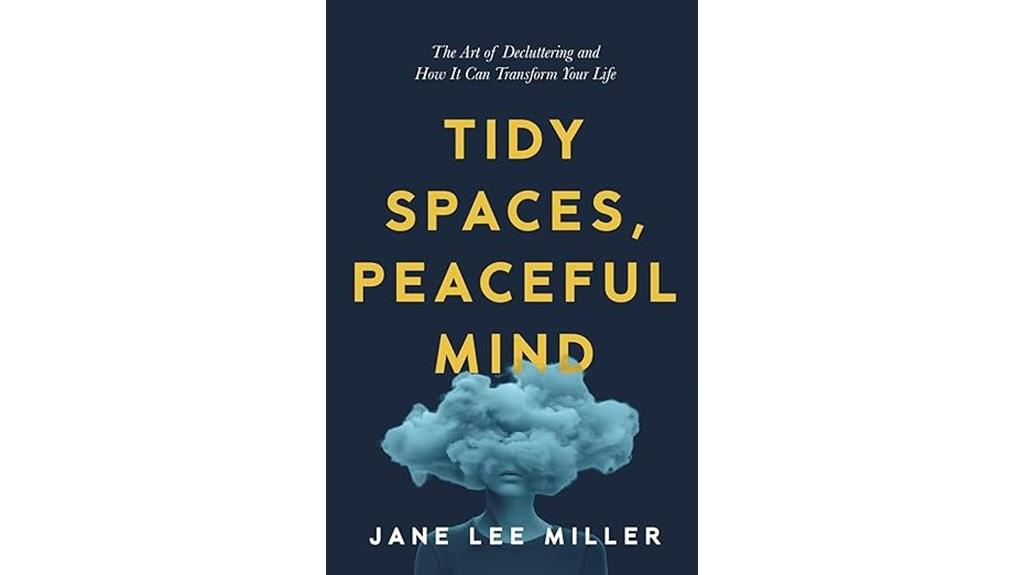
If you're feeling overwhelmed by clutter and seeking a sense of calm in your space, "Tidy Spaces, Peaceful Mind" is your perfect companion. Jane Lee Miller's book offers practical strategies to help you declutter your home and life. I love how she breaks the process down into manageable tasks, like focusing on a single drawer instead of the whole house. This approach makes decluttering feel achievable. Plus, I appreciate the emphasis on the mental benefits; a tidy environment really does promote tranquility. With Miller's engaging style, you'll feel empowered to create a peaceful, organized space that boosts your productivity.
Best For: Individuals seeking practical strategies to declutter their homes and improve their mental well-being.
Pros:
- Offers manageable micro-decluttering tasks that prevent overwhelm.
- Emphasizes the psychological benefits of a tidy environment, fostering tranquility.
- Engaging and accessible writing style that motivates readers to take action.
Cons:
- Could benefit from more real-life anecdotes and specific examples, especially for digital decluttering.
- Some sections may feel repetitive to certain readers.
- Lacks support tools like sample routines or images to enhance understanding of the methods.
Factors to Consider When Choosing The Decluttering Tools to Streamline Your Life
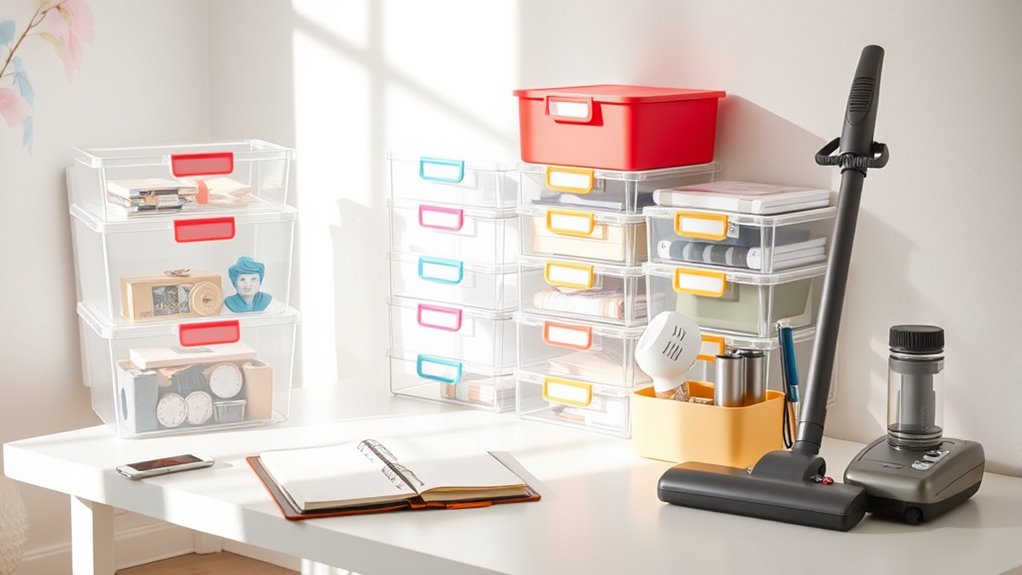
When I choose decluttering tools, I consider my personal organization style and how my emotions tie into my belongings. It's crucial to think about the specific needs of each room and the practicality of the tools I select. Additionally, I always factor in the time commitment required to make everything work seamlessly.
Personal Organization Style
Understanding your personal organization style is essential for effective decluttering. It shapes how I tackle the process—whether I prefer a systematic room-by-room method or a category-based approach. If I thrive on visual cues, I might lean toward color-coded systems or labeled bins that make organization easier. I also recognize that my tendency to procrastinate calls for tools that break tasks into bite-sized chunks, helping me maintain momentum. Additionally, I need to decide if I want a structured system with checklists or a more flexible method that allows spontaneity. By evaluating these aspects, I can choose decluttering tools that truly resonate with my style, making the entire process smoother and more efficient.
Emotional Attachment Considerations
Emotional attachments to our belongings can complicate the decluttering process, making it tough to let go of items tied to cherished memories or significant relationships. I've found that recognizing gifts and heirlooms shouldn't become obligations helps me alleviate guilt when deciding what to keep. It's important to honor my emotions during this process, allowing myself to feel and reflect on what each item means. Grouping similar items together simplifies my decision-making, making it easier to evaluate their emotional significance. Shifting my mindset to prioritize space and mental clarity over attachment to physical items empowers me to take actionable steps. Ultimately, I can create a more peaceful environment that supports my productivity and well-being.
Room-Specific Needs
As I navigate the decluttering journey, I quickly realize that each room presents its own unique challenges and needs. Kitchens, for instance, require tools to organize utensils and food, while bedrooms need systems for clothing and personal items. It's crucial to reflect on the activities in each space; living rooms benefit from managing entertainment systems, whereas home offices need organization for documents. The size and layout matter too—small spaces call for multi-functional tools to maximize storage. I also pay attention to emotional aspects; sentimental items in bedrooms need gentle handling. Finally, I tailor solutions based on usage frequency—entryways need easy-access storage, while rarely used areas can afford hidden solutions.
Practicality and Usability
Each room's specific needs guide my choices, but practicality and usability are equally important when selecting decluttering tools. I look for tools that offer clear, actionable strategies I can easily incorporate into my daily routine. Visual aids like diagrams or checklists enhance usability, simplifying the decluttering process and keeping me engaged. I also appreciate tools that allow for customization, adapting to different spaces and my personal preferences. Incorporating bite-sized tasks, such as "10-minute daily tactics," makes the process less overwhelming and encourages consistent progress. Additionally, effective tools address the emotional connections I have with my belongings, helping me navigate attachment and guilt while promoting a compassionate approach. This balance makes decluttering feel manageable and meaningful.
Time Commitment Required
When choosing decluttering tools, the time commitment they require is crucial to take into account, especially since some methods can demand more time than I can realistically allocate. I prefer tools that break down decluttering into bite-sized tasks or shorter projects, as these fit more easily into my busy routine. Quick daily routines or 10-minute tasks are a game-changer for me, allowing consistent progress without overwhelming my schedule. It's also important to evaluate whether the tool encourages regular maintenance to keep clutter at bay in the long run. I always assess my personal availability and energy levels, knowing that tools requiring significant upfront time might not be suitable for my demanding lifestyle.
Budget-Friendly Options
While decluttering might seem intimidating, there are plenty of budget-friendly options that can help streamline the process without putting a dent in your wallet. I love using repurposed items like boxes or baskets as storage solutions; they're perfect for organizing without spending a dime. Plus, I follow the "one in, one out" rule, donating or discarding an item every time I bring something new home. Local libraries and donation centers often offer free workshops or materials on decluttering techniques, which I've found incredibly helpful. I also explore online platforms for free guides and checklists. Engaging in a decluttering challenge with friends or family keeps me accountable and motivated, all without any costs involved!
Long-Term Maintenance Plans
To maintain a clutter-free environment, I've found that establishing a long-term maintenance plan is essential. I schedule regular decluttering sessions, whether monthly or seasonally, to prevent unnecessary accumulation. Adopting a "one in, one out" policy has been a game changer, making me remove an item for every new acquisition. I also create designated spaces for my belongings, ensuring everything has a home, which keeps chaos at bay. Visual reminders like checklists and calendars motivate me to stay on track and monitor my progress. Ultimately, involving my family in these routines fosters a sense of collective responsibility, making it easier for all of us to sustain a tidy environment over the long run.
Supportive Community Resources
Maintaining a clutter-free environment isn't just about personal effort; it often requires the support of a community. I've found that engaging with local decluttering groups or online forums can provide the motivation I need. When I share my experiences and challenges with others who get it, I feel empowered and less overwhelmed. Community resources often host workshops that offer practical strategies and hands-on assistance, making the process more interactive. Plus, having peers to share my goals with helps me stay accountable. I've learned so many tips and techniques from others, enriching my approach to organization. Joining a community makes decluttering feel less isolating and transforms it into a collaborative journey.
Frequently Asked Questions
What Are the Best Apps for Tracking Decluttering Progress?
I've found a few apps really helpful for tracking my decluttering progress. My favorites include Todoist for organizing tasks and Habitica, which gamifies the process, making it fun. I also like Clutterfree, as it lets me set specific goals and visualize my progress over time. By using these tools, I stay motivated and can see how far I've come. It's amazing what a little tracking can do for my decluttering journey!
How Can I Stay Motivated During the Decluttering Process?
Think of decluttering like shedding old skin; it's uncomfortable but necessary for growth. To stay motivated, I set small, achievable goals, celebrating each little victory. I visualize my space transformed, picturing how peaceful and organized it'll feel. I also play my favorite music to make the process enjoyable. When I hit a wall, I remind myself of the freedom that comes with less clutter, keeping my eyes on the prize.
Are There Professional Organizers Who Can Help Me?
Absolutely, there are professional organizers who can help you! I've found that working with someone who has expertise in decluttering makes the process smoother and more efficient. They provide tailored advice and hands-on assistance, making it easier to tackle even the most overwhelming spaces. If you're feeling stuck, hiring a professional could be the boost you need to get started and maintain your progress. It's definitely worth considering!
What Are the Most Effective Storage Solutions for Small Spaces?
Imagine your small space transforming into a cozy haven instead of a cluttered maze. I've found that vertical shelving is a game changer, using walls to their full potential. Baskets and bins help me organize items while keeping them stylish. Multi-functional furniture, like ottomans with storage, makes every inch count. Finally, clear containers let me see everything at a glance, making it easier to find what I need without digging through clutter.
How Often Should I Declutter My Home?
I've found that decluttering my home every few months works best for me. It keeps my space feeling fresh and organized. I usually set aside a weekend to tackle each room, focusing on what I really need and love. If I notice things piling up, I'll do a quick check every month. Finding a rhythm that feels right for you is key, so don't hesitate to adjust as needed!
Conclusion
As I sift through my clutter, I see chaos on one side and clarity on the other. Each tool I choose acts like a bridge, connecting me from the overwhelming mess to a serene space where productivity thrives. It's a journey from feeling lost to discovering what truly matters. Embracing these decluttering tools isn't just about tidying up; it's about crafting a life that reflects my values and aspirations, allowing me to breathe easier and live fuller.


